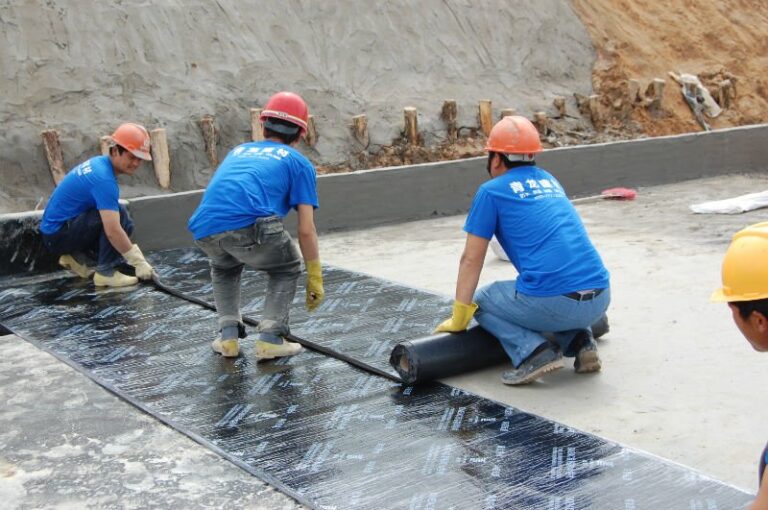Waterproofing is critical in the construction and building maintenance industries for preserving the durability and integrity of buildings. The waterproofing membrane is an important component of contemporary waterproofing systems. This article will dig into the topic of waterproofing membranes, investigating their many varieties, advantages, uses, and importance in the building business.
Table of Contents
Waterproofing Membranes: An Overview
A waterproofing membrane is a thin layer or sheet-like substance that prevents water from entering a building or structure. It acts as a barrier, preventing water from penetrating the underlying surfaces and causing structural damage, degradation, and even mold formation.
Roofs, basements, balconies, tunnels, and swimming pools are all frequent places where waterproofing membranes are employed.
Different Types of Waterproofing Membranes
1. Bituminous Membranes Bituminous waterproofing membranes are composed of asphalt and polymers. They are often used in torch-on applications, in which the membrane is torched to produce a watertight seal. These membranes are very resistant to UV radiation and harsh weather conditions and have good waterproofing qualities.
2. Polyurethane Membranes: Polyurethane membranes are adaptable since they may be used as liquid coatings that cure into flexible, seamless membranes. They cling effectively to a variety of substrates and may withstand structural movement while remaining watertight.
3. Polyvinyl Chloride (PVC) Membranes:
PVC membranes are thermoplastic polymers that are often used in roofing. They are well-known for their long life, resilience to UV rays, and simplicity of installation. PVC membranes come in a variety of colors and thicknesses, making them a popular option for both practical and aesthetically pleasing applications.
4. Ethylene Propylene Diene Monomer (EPDM) Membranes:
EPDM membranes are exceptionally durable synthetic rubber membranes that are resistant to ozone and UV radiation. They are often used in roofing applications and come in huge sheets that may cover enormous areas with little seams.
5. TPO (Thermoplastic Olefin) Membranes:
TPO membranes are single-ply roofing membranes with superior heat-welded seams and energy efficiency. They are well-known for their reflecting surfaces, which may assist in minimising cooling expenses in a building.
The Advantages of Waterproofing Membranes
Waterproofing membranes provide various advantages for construction projects and building maintenance:
1. Water Conservation: The fundamental function of waterproofing membranes is to prevent water intrusion, which may cause structural damage and material deterioration.
2. Lifespan: Waterproofing membranes that are properly placed and maintained may prolong the life of buildings and structures by protecting them from moisture-related concerns.
3. Affordability: While waterproofing membranes have a larger initial investment, the long-term benefits in terms of lower maintenance and repair expenses make them a cost-effective alternative.
4. Adaptability: Waterproofing membranes may be applied to a variety of surfaces, including flat and sloping roofs, walls, and foundations, making them versatile in terms of architectural design.
5. Seamless Protection: Many waterproofing membranes, particularly liquid-applied ones, provide seamless barriers that remove seams and joints.
Waterproofing Membrane Applications
Waterproofing membranes are used in a variety of building and infrastructure applications, including:
1. Roofing:
Roofs are vulnerable to water damage due to their exposure to extreme weather conditions. Roof waterproofing materials are often used to prevent leaks and degradation.
2. Basements:
Because of their below-ground placement, basements are vulnerable to water incursion. Waterproofing membranes keep moisture out of basements, which may lead to mold development and structural problems.
3. Decks and Balconies:
Balconies and decks, for example, are continually exposed to the elements. Waterproofing membranes provide a barrier that prevents water from infiltrating concrete or other materials.
4. Swimming Pools:
To prevent water from leaking into the ground and causing damage, pools need specialized waterproofing. Waterproofing membranes developed for aquatic conditions extend the life of the pool.
The Importance of Waterproofing Membranes in the Construction Industry
The building industry has recognized the vital role that waterproofing membranes play in the maintenance of structural quality and durability. Buildings are prone to a variety of problems if sufficient waterproofing measures are not implemented, including:
1. Degradation of Structure: Water penetration may weaken concrete, erode reinforcing bars, and jeopardize the building’s overall structural integrity.
2. Mildew and mold growth: Excess moisture creates an excellent habitat for mold and mildew to develop, resulting in poor indoor air quality and significant health risks.
3. Interior Damage: Leaks may cause interior finishes such as walls, ceilings, and floors to deteriorate, resulting in expensive repairs and aesthetic difficulties.
4. Energy Depletion: Water penetration may also have an influence on a building’s energy efficiency by enabling heat or cold air to escape, causing energy demand to rise.
Waterproofing membranes are critical components of contemporary building construction and maintenance.
Their ability to build efficient water barriers assures the lifespan, safety, and sustainability of buildings. These membranes offer an important layer of protection that protects structures from the destructive effects of moisture, from roofs to basements, balconies to tunnels.

